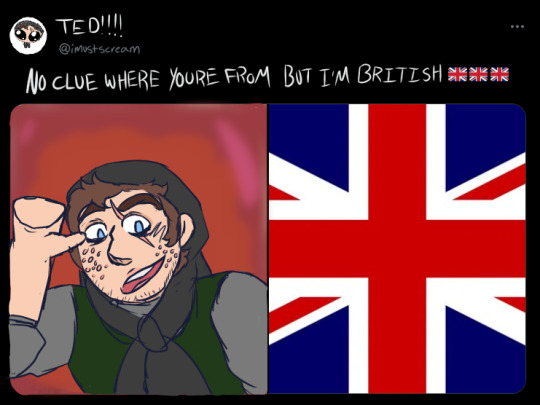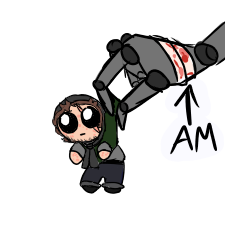#is it concerning that i probably kin ted
Explore tagged Tumblr posts
Text
Someone let me listen to the I Have No Mouth and I Must Scream radio drama done by BBC and now I have a new hyperfixation.
Anyways I've gone and drawn a bunch of shit because Ted is my little guy and I understand him on such an uncomfortable level. Merry Christmas, I guess? I was just relieved to find out that IHNMAIMS has a fandom






How do we feel abt autism creature Ted IHNMAIMS.
#i have no mouth and i must scream#ihnmaims#ihnmaims ted#ihnmaims ellen#did yall listen to the radio drama#it goes HARD man#is it concerning that i probably kin ted#i think it may be#anyway#expect more
111 notes
·
View notes
Note
The FAILING New York Times recently asked their columnists to select “the one piece of culture that, to them, best explains America." The majority of responses are what you'd expect. (Ted fucking Lasso?) Personally, I'm a Melville's The Confidence-Man man, but I'm curious to hear your response.
I mean, it's probably that James O'Keefe video I just referenced. But seriously, folks...it's got to be "Self-Reliance." Pretty much everything good and bad flows out of this, including unembarrassed citations of TV ephemera from would-be literati and other cultural elites:
Whoso would be a man must be a nonconformist. He who would gather immortal palms must not be hindered by the name of goodness, but must explore if it be goodness. Nothing is at last sacred but the integrity of your own mind. Absolve you to yourself, and you shall have the suffrage of the world. I remember an answer which when quite young I was prompted to make to a valued adviser, who was wont to importune me with the dear old doctrines of the church. On my saying, What have I to do with the sacredness of traditions, if I live wholly from within? my friend suggested,—“But these impulses may be from below, not from above.” I replied, “They do not seem to me to be such; but if I am the Devil's child, I will live then from the Devil.” No law can be sacred to me but that of my nature. Good and bad are but names very readily transferable to that or this; the only right is what is after my constitution, the only wrong what is against it.
I didn't love The Confidence-Man, found it claustrophobic and cynical, the kind of angry old man cynicism that's kin to sentimentality, as you also find in Twain or Vonnegut, whom I also don't love. I prefer Melville when he's sublime or when he's perverse or when he's elegiac. If I were going to pick a novel, it might be The Scarlet Letter, which contains most of the national character except the race stuff, and explains the entirety of the cultural logic—even re: the race stuff—by which Emerson's antinomianism doesn't spin off into total madness. Just for fun, here's the opening paragraph, in the same vein, of Harold Bloom's Introduction to his Modern Critical Views volume on Pynchon:
We all carry about us our personal catalog of the experiences that matters most—our own versions of what they used to call the Sublime. So far as aesthetic experience in twentieth-century America is concerned, I myself have a short list for the American Sublime: the war that concludes the Marx Brothers’ Duck Soup; Faulkner’s As I Lay Dying; Wallace Stevens’s “The Auroras of Autumn”; nearly all of Hart Crane; Charlie Parker playing “Parker’s Mood” and “I Remember You”; Bud Powell performing “Un Poco Loco”; Nathanael West’s Miss Lonelyhearts; and most recently, the story of Byron the light bulb in Pynchon’s Gravity’s Rainbow.
#american literature#american culture#ralph waldo emerson#nathaniel hawthorne#herman melville#harold bloom#thomas pynchon
3 notes
·
View notes
Text
Outrageous Fortune Reviewcap: S1E03 (”A Little More Than Kin”)
So, remember what I said about how Jethro’s lie about being part-Maori gets dropped pretty quickly? Well, it does, but not before we have to sigh and sit through an episode about it. It’s a silly idea from two directions - firstly, Jethro is very clearly white as snow, and secondly there’s no way the law firm at which he clerks would have been that lazy with their background checks - but it does, at least, provide us with a plot that gives the writers a chance to more firmly establish Jethro’s personality, and give us a few more clues into what makes him tick.

Cheryl loves Jethro because he’s a shining example to the rest of the family, proof that it’s possible for a West to go straight and live a life not defined by crime and dysfunction. And he is, accordingly, first seen in this episode working on some sort of legal problem, apparently on behalf of a Maori group who are in a dispute with a corporation (the details are left vague, probably for the better). But he soon falls into a dispute with cocky, intensely irritating fellow law clerk Hugh, who is somehow the only one who’s figured out that Jethro isn’t really Maori and figures he can use it to blackmail him. Jethro’s reaction to this is interesting, and troubling.

Hugh steals a piece of evidence Jethro found, hoping to claim credit for it himself and trusting that he has enough material on Jethro to prevent him from doing anything about it. I don’t think he ever had anything to worry about on that front, though - Jethro seems serious in his moral opposition to snitching (”family thing”, he says) and immediately opts to resolve the issue through dirty means. He gets Hugh drunk while Van and Munter raid his home, taking both the evidence he stole and a good deal more besides; Hugh ends up drunkenly revealing that he’s gay, which Jethro then immediately proceeds to use to turn the tables and blackmail him, trusting that the legal profession is still institutionally homophobic enough that it’ll be enough to keep him off his back.

Now, one might say that fair’s fair, and that Hugh was only reaping what he sowed here. I’m not gonna dispute that, exactly - it’s certainly difficult to feel any sympathy for the asshole, and the fact that he’s just performing heterosexuality doesn’t excuse the creepy way he behaves around women. But one can’t help but imagine that there were probably a whole bunch of ways Jethro could have handled this situation without resorting immediately to the traditional West route, and that depriving Hugh of so much expensive property for the simple crime of trying to take credit for some of Jethro’s work might actually be a teensy bit of an over-escalation. And then there’s the important matter of the qualitative difference between the two blackmails: Hugh is blackmailing Jethro over a lie he’s telling to cynically advance his own career at the expense of members of a disadvantaged minority, while Jethro is blackmailing Hugh over actually being a disadvantaged minority.
So I don’t buy that this is a justified response. It is, rather, the first real set of evidence we have that Jethro’s apple really didn’t fall very far from the tree after all. He recruits Van into his scheme with full knowledge that Cheryl wouldn’t approve if she knew, fully understanding her mission and choosing to ignore it; he tries to convince his female PA to take Hugh home with her as part of the distraction, not yet knowing that he isn’t heterosexual and not at all caring that he gives her the creeps; and not once does he ever display any guilt for pretending to be Maori in order to receive what Hugh calls “brownie points”, not even when he’s clumsily speaking te reo to their faces. “You are one of them Wests, aren’t you?” says a shocked Hugh at the end; indeed he is, even if Cheryl is blind to it.

Speaking of Cheryl, she is once again the focus of the other main plot here, and it concerns similar themes. She leaves her supermarket job - voluntarily this time - and takes up work with a man called Allen, the husband of her cancer-stricken friend and himself an old friend of Wolf’s. But his motives turn out to be mighty impure, and the result is another mess.
It’s not the most interesting plot the show ever did - it’s a little predictable, honestly - but it does give us more insight into Cheryl’s own personality, and gives us more of a handle on one of her most important flaws. Early in the episode, at a party for the aforementioned friend, a drunk Eric doesn’t take no for an answer and has to be forced off Cheryl by Allen; an attempted sexual assault like that should be an instant friendship-ender, but the moment Eric’s gone Cheryl brushes it off, blaming it on the drink and absolving the man himself. Later, when Allen himself finally gets too horny and starts getting incredibly - and aggressively - inappropriate at work, Cheryl treats it probably far more frivolously than she should, and even after the police (unrelatedly) show up, she continues to insist that he’s a decent man. It’s a permissiveness she must have learned in the course of her marriage with Wolf, and it serves her ill.

It’s ironic, considering how hyper-sensitive she is to the danger of anything similar happening to Pascalle. She finds out that she works as a waitress in a strip club - a truth she presses out of Loretta, who seems remarkably uninterested in exerting any particular effort to maintain the lie - and warns her of the likely ulterior motives of her new boss; Pascalle rejects the counsel (loudly), citing Cheryl’s decision to work for “creepy uncle Allen”, and she does turn out to have something of a point. On the one hand, one totally feels for Cheryl’s concern for Pascalle, considering the latter’s naivete and vulnerability; on the other hand, one totally understands Pascalle, who knows that her mother doesn’t really like or properly respect the direction in which she’s taking her life anyway and is most probably correct to see some moralistic hypocrisy in her motives. Eventually Cheryl does accept Pascalle’s decisions, if only reluctantly, and the two mend the bridge; this is well-timed, because shortly thereafter Cheryl finds several of her other bridges afire.
This, see, is where Wolf comes into it. His part in this episode doesn’t tell us much we couldn’t already at least guess about him, but it is, at least, good to see it properly laid out that he is one of those men who gets incredibly paranoid in his possessiveness about his wife, and that, in turn, suggests things about him that haven’t yet been revealed.

He’s a real bastard this episode, truly in unapologetic antagonist mode. He correctly guesses what, exactly, it is that Allen wants, even as Cheryl denies it, but he can’t bring himself to trust her to actually deal with it herself; instead, he immediately starts to undermine her, first by contradicting her about Pascalle (expressing approval of her new job, which Cheryl correctly notes would be unthinkable if he’d heard about it first) and then by breaking his own no-snitching code and getting Allen busted for various illegal side-activities, shutting down his entire business and depriving Cheryl of her income. After all his bleating about their children’s futures last episode, it’s instructive to see his priorities laid out: he might, indeed, value those futures, but he values his own possession of his wife’s purity more, and he’s willing to do anything necessary to protect it, no matter how much harm it causes. Of course, the fact that a man who assumes his woman would cheat on him at first opportunity is most probably projecting his own personal history goes unmentioned by any of the characters in the episode, but it’s hanging in the background nonetheless, especially considering what he knows about his friend Allen. ”Can’t keep his dick in his pants”, indeed - judge a man by the company he keeps.

This finally wears Cheryl down to breaking point, and her usual tolerance for Wolf’s malfeasance dries up. Her confrontation with him at the end, dressed expensively, is brilliant; Wolf’s first thought is not of her, but of him, and you can tell by the way his first reaction upon seeing her is to immediately and dangerously look round at all his fellow inmates to make sure they aren’t checking her out before accusatorily asking her why she’s dressed to invite their potential stares. Cheryl says she doesn’t wanna see him for a while; Wolf does his best to look like he’s just accepting it, but you can tell it gets to him. And yet for all his sadness, he still doesn’t seem particularly introspective; his self-confidence is too great to be truly pierced by any one thing, even this.
For the most part, that’s it for the episode. Loretta appears just long enough to get perved at by an inmate, drop her sister in the shit and drop a couple of her usual zingers, including one satisfyingly aimed at Eric; Ted remains a mince-joke machine and nothing else. Wayne Judd appears briefly, being less confrontational with Cheryl than he was before (take note of this). The school headmistress reminds us all that she’s Jethro’s girlfriend, a fact I forgot to mention until now because it hasn’t been important yet. The next episode will feature every important character (save Ted, who has a few episodes to go yet) in important roles, and it happens to be one of my favorite episodes in the entire show. Onward!
#antonia prebble#siobhan marshall#antony starr#robyn malcolm#grant bowler#television#outrageous fortune#frank whitten#rachel lang#gutter black#nz
6 notes
·
View notes
Text
A Chain Of Its Own: Mobile App Kik To Fork Stellar For Fee-Free Blockchain
The cryptocurrency which will shortly facilitate power the popular Kik electronic communication app is creating a giant technology shift -- once more.
Kik's crypto token, kin, presently exists as AN ethereum-based ERC-20 token, nevertheless CoinDesk recently reported that'd the corporate would be moving to a two-chain system whereby its tokens were supported on each the ethereum blockchain and also the stellar blockchain. But today, the Kin Foundation, the non-profit organization managing the event of kin, has declared another move, deciding instead to fork stellar to form its own blockchain.
Kik Friends
While Kik had initial unreal the two-chain system as a result of it upset concerning group action fees on ethereum - a blockchain that pushed up against its scale once the crypto-collectable cat game, CryptoKitties, went microorganism - Kik has set that even stellar's minimal fees were an excessive amount of for what the corporate hopes to accomplish.
For its kin token, the matter with stellar is that it prices a small quantity to create a group action thereon blockchain, which should be paid in lumens, stellar's native cryptocurrency.
Whereas on Kik's own blockchain, transactions will not value something.
This is particularly necessary given Kik's goal for its cryptocurrency - to facilitate micropayments, as little as a penny or perhaps less, across the net additional expeditiously. the speculation is that, if these seamless transactions area unit attainable, entrepreneurs can begin making new digital services that encourage transactions between users for things like cheap personal chats, digital gifts (like stickers or gifs), personalised photos and additional.
Speaking to CoinDesk concerning the choice, Kik CEO Ted Robert R. Livingston told CoinDesk:
"I assume what makes Kin distinctive is it's one in every of the only a few comes wherever product is driving the technology and not the other way around."
To encourage entrepreneurs to form these services on the Kik app, the Kin Foundation features a large pool of kin in reserve that it'll use to mechanically pay entrepreneurs for fostering economic activity, referred to as the Kin Rewards Engine (KRE). The KRE can pay out a share of kin each day, profitable every app supported what quantity economic activity it generated that day.
According to the announcement weekday, all that activity can currently occur on kin's blockchain.
Yet, ethereum can still be concerned. once a founder has earned enough kin that they need to carry, the thought is that they may use a method referred to as atomic swaps to maneuver their kin over to ethereum. In short, each kin token can exist on 2 ledgers: one on the ethereum blockchain and one on the kin blockchain.
Kik Usernames
When its kin 0.5 is in an exceedingly user's notecase, the ethereum 0.5 is barred up in an exceedingly good contract, and the other way around.
But whereas this is often the roadmap nowadays, Robert R. Livingston will not hazard a guess concerning once this technique can formally go live. Although, the corporate is presently moving forward with building its own ASCII text file codebase, cloned from the stellar protocol and, as Robert R. Livingston place it, "taking destiny into our own hands."
Federated nodes, zero fees While Robert R. Livingston remains optimistic on stellar, having evaluated different blockchains as he probe for possible solutions, stellar still wasn't precisely the right acceptable Kik.
"It wasn't that the fees were too high, it's that they value one thing which created AN incentive for spammers," he said.
While originally, the team had thought it may simply subsidize the group action fees, they shortly completed that it'd ought to place lumens in people's wallets to try and do that. As such, they theorized that dangerous actors may then simply produce a bunch of wallets and come up the lumens, in a trial to secure enough cash to create a bearing on the network.
As such, Kik has created a fee-less proprietary blockchain, and have done thus with the utilization of established, permissioned nodes.
"When you examine the Stellar network and compare it with Kin's fork of Stellar, the 2 networks area unit identical, with one exception: the folks running the federation nodes," Robert R. Livingston aforesaid.
For instance, the Kin Foundation can run the primary node, however Robert R. Livingston aforesaid, that because the company brings on additional partners, those partners are expected to run sure nodes, too. As such, although the Kin Foundation can ab initio management the blockchain, as a result of all nodes are treated equal, eventually the foundation's ballot power over the network can diminish.
Unlike nodes within the stellar federation, these partners will not earn something for confirmative transactions (if they did, there would want to be a group action fee). however Robert R. Livingston believes future kin nodes are surpass the big services driving the kin economy, those that earn lots of financial gain through the KRE, thus have a robust interest in seeing the worth of kin grow steady and in and of itself, can volunteer as nodes.
"As additional digital services come back on board, and because the Kin system gets larger and also the client base gets larger, there is additional incentive for additional folks to run these united nodes," Robert R. Livingston aforesaid.
This move, whereas commercialism off some decentralization for top output, aligns with what some business analysts, as well as Blockchain Capital's sociologist player, have foreseen as a forthcoming trend. player worries that these systems can become not innovative blockchain systems however ones that gibe this centralized systems we've nowadays.
But Robert R. Livingston argues that distinction is trustlessness.
"If this is often planning to be a standard currency between billions of customers across thousands of digital communities, we'd like it to be trustless," he said, adding that customers will rest assured that it is not attainable for anybody entity on the network to require their cryptocurrency from them.
But censorship resistance? Yet, what may suffer during this united node model is cryptocurrency's initial cause - censorship resistance.
For instance, if the kin token ran on stellar, validation would be cut loose use cases. Validators would earn financial gain from securing the network, and firms building services to use kin would have paid those validators in fees to be used of the network. however beneath Kin's new vision, the larger corporations driving the general public facing use cases also will offer back-end validation.
And those are corporations UN agency may jointly decide, as an example, to ban a service viewed as offensive or malicious from exploitation the network (in different words, to censor it).
Think of it like this: imagine that the net nowadays were inbuilt the same thanks to the kin blockchain. the massive nodes - services in all probability like Ebay, Etsy, Vimeo et al. that with success encourage folks to pay cash with one another - may get along and choose to dam a site's transactions that they or their users assume is offensive.
Would the stellar nodes created from for the most part unknown back-end net services corporations cave to collective social pressure before a bunch of corporations with widespread name recognition and an oversized base of client users conceive to act as dictator?
Knowing that the latter is perhaps additional possible, this is often what several crypto enthusiasts wish to protect against through the utilization of suburbanized cryptocurrency protocols.
It's a question Robert R. Livingston has grappled with, however contends it's AN exception that perhaps is not as dangerous because it sounds.
"The question is a smaller amount concerning the terrible stuff of the planet. that is stuff we're all planning to ought to grapple with as a worldwide society," he said, adding, "The question is additional concerning centralized powerCould Kin become a centralized authority within the kin ecosystem? and that we wish the solution thereto to be no."
Governance, Robert R. Livingston continuing, is one in every of the foremost fascinating topics in cryptocurrency immediately, and also the team behind kin is pondering of these issues actively.
He concluded:
"I assume the very exciting issue from AN engineering purpose of read is kin is at the haemorrhage fringe of determination these blockchain challenges and leading the business there."
Bike chain image via Shutterstock
The leader in blockchain news, CoinDesk could be a media outlet that strives for the best print media standards and abides by a strict set of editorial policies. CoinDesk is AN freelance in operation subsidiary of Digital Currency cluster, that invests in cryptocurrencies and blockchain startups.
6 notes
·
View notes
Text
Finale Draft for Annotated Bibliography
The science of altruism (TED):
Published June 29th, 2016. Religious def: loving others as you love yourself. “Altruism is what defines who we are as humans and where we come from.” Survival of the fittest. Cooperation has been found to be more effective than the survival of the fittest for a species as a whole (Ex. ants/bees/primates/ bats etc.) (Think of my bio-anthropology class lesson when we talked about this.) Controlled experiments with toddlers where someone will drop something or try to complete a task. TWO main things happen- babies/toddlers will normally try to help and pupil dilation that is linked to concern or empathy happened (When babies couldn’t help their pupils dilated more.) An argument against altruism is people are ration and self-interested (ex. Baker baking bread to sell for money for himself instead of feeding people) BUT people make irrational decisions all the time for various reasons, we are complicated with altruistic tendencies. He then talks about race privilege and inherent advantages in institutions which I didn’t understand how it connected. He claims altruism is in our genetic legacy
TEDx Talks. “The Science of Altruism | Dustin Daniels | TEDxFSU��� Youtube, June 29th, 2016, https://www.youtube.com/watch?v=brqg4HA3mUI&feature=youtu.be.
Richard Dawkins on Altruism and The Selfish Gene (video of Dawkins):
Published September 1st, 2012. Charles Darwin argued in his book origin of species that the evolution of life on earth evolved through a brutal competition of existence. Altruistic behaviors in animals could include warning cries, group grooming. Richard Dawkins uses the science of genetics to crack the code of altruism. Genes are what build us up and make who you are. Dawkins claims we are survival machines who carry our genes and our goal is to pass on the genetics through reproduction so they live on, (essentially genes are immortal. The survival of the fittest really only means the survival of the genes. A gene that did not look after itself would not survive; the meaning of selfish gene
How do selfish genes give us altruistic behavior? Different answers: Kinship- the altruistic gene is passed around a family and given kin selection where they will do what it takes to make sure their family survives. Reciprocal altruism- you scratch my back, I’ll scratch yours. Give favor to receive one back someday. But wait those can’t be the only reasons b/c after all humans give to charity, give blood, cry at the blight of strangers and humans are generally nicer than the selfish gene theory would suggest- Goes against the dog eat dog world that Darwinism suggests. There are arguments against the selfish gene theory like consultation behavior seen in chimps. The veneer theory- the idea that morals are a thin veneer on top of the inherent animal nature of us. The veneer theory argues that humans are inheritably selfish and nasty. Darwin suggests that we have gone beyond kin selection and that humans have a lust to be nice. Such as be nice to whoever you meet because in nature animals are parts of small groups where they know everyone in their group more likely to be surrounded by kin and cousins. That could still be there in humans but we have gone too big and now feel that way with everyone. Darwin compares being nice to being horny. A misfiring of the gene. EX: Humans are horny in nature to reproduce but now we have contraception to not have kids but we are still horny knowing we have kids-that is a misfire of that gene. Being nice to people could be wired into us from when humans lived in small groups of close kin and groups of close acquaintances within it would pay to reciprocate favors.
Andy80o, “Richard Dawkins on Altruism and The Selfish Gene”. Youtube, September 1st, 2012, https://www.youtube.com/watch?v=n8C-ntwUpzM&feature=youtu.be.
The Biological and Evolutionary Logic of Human Cooperation (paper):
Published 2005 Intro talks about how there is a debate between reciprocal altruism and altruism for the good of the group (in humans.) The scholars (the collective) write that “human prosocial behavior is fundamentally incompatible with the economists model of the self-interested actor and the biologist’s model of the self-regarding reciprocal altruist. Basically saying humans are NOT only nice to receive a benefit for it. The collective argues that the solution to the puzzle is an altruistic human pre-disposition to work for the good of the group, arising by group selection. That view contradicts decades of work in biology, economics, and other fields which say humans are only altruistic for underlying selfish reasons. Strong reciprocity- a descriptive term for “people tend to behave prosocially and punish antisocial behavior at a cost to themselves even when the probability of future interactions is low or zero”-- Basically being nice to someone you will most likely never see again. The question isn’t IF people do that or not (it is known people do) but WHY. Different ideas on why we are altruistic: kin Selection- acts benefiting genetic relatives, reciprocal altruism- scratch my back ill scratch yours, indirect reciprocity- acts are given based reputation (not wanting a bad one) and signaling- signaling others you are nice so they should be nice to you. All those give back to the altruist. The collective argues that it’s none of that but instead, it is a genuine force not explained by those four mechanisms. Where they differ is on the origin of the altruistic behavior. Conclusions: Behavioral mechanisms are not perfect goal-seeking devices BUT INSTEAD, context-specific physiological systems that respond to environmental cues in order to engage what was, on average over the course of evolutionary history, the appropriate action. A study found humans would do more good to others and the environment when watched by a robot with human-like eyes. Studies did find that cooperation increases when you add in Kinship. It was found that human cooperative mechanisms are not in equilibrium with our environment. They argue that there is a biological (proximate) and evolutionary (ultimate) logic to human cooperation. One theory is that our social environment (society) has advanced in a gene’s eye blink (really fast) and that our brains are the same, leaving humans with strange tendencies leftover from past eras. Leading to this being the answer to the puzzle. According to the collective “the moral sentiments that have lead people to value freedom, equality, and representative government is predicated upon strong reciprocity.” But we can not RELY on people being naturally nice due to any of the theories above (ex; pirate rule in 18th century or other war stuff) BUT b/c humans can not be relied upon for the good of the group we must craft social, economic, environmental and political interactions to ensure cooperation against selfish temptation.
Burnham, Terence C., and Dominic D. P. Johnson. “The Biological and Evolutionary Logic of Human Cooperation.” Analyse & Kritik, vol. 27, no. 1, Jan. 2005. OneSearch, DOI: https://doi.org/10.1515/auk-2005-0107
Can Altruism be unified (paper):
Published November 14th, 2015. Different kinds of altruism (ex. Biological/evolutionary altruism and psychological altruism.) Biological altruism focuses on fitness exchanges- what are the outcomes? Psychological altruism is based on the intentions- an act is Psychological, not due to the outcomes but due to the intentions of the actor. There are other forms that are not just biological or psychological- which we will call helping altruism. The goal of this paper is to clarify the taxonomy of altruism concepts and to consider whether this diversity merely constitutes distinct concepts loosely related and collected under the rubric of altruism or if there is a deeper unity. There is no set number amount of concepts of altruism, it depends on implied meanings in various uses of altruism. But a study in 2013 has made four (4) distinct concepts that are widely used but in this study, she is making several adjustments to that and making her own three (3). Biological Altruism- altruism tied to biological fitness. Linked to core behavioral dispositions (give example.) Psychological Altruism- The actor just wants good for others with no reward. Based on facts about the psychological states of individuals. (give example.) Helping Altruism- The concept that humans help other humans just for the sake of doing the action of helping someone. By definition, this behavior does not rely on an individual psychological state but as humans as a whole. (give example.) How are these all connected together? She argues that altruism is simply polysemous- that the same word is used for what are clearly distinct concepts. Claims since all are labeled altruism that they all have some kind of connection with them but they are all different. In the paper, it claims each type of altruism can be independent of the other two. Ex. assisted suicide could count as helping, despite being detrimental to fitness; tampering with birth control may be unhelpful, despite promoting biological fitness. (a nested view that they are all connected is wrong in her words.) But, she claims altruism is still all one big family of an idea. They are all altruism and any act that falls under those three is an altruistic ideal. She argues that there is a one big framework/framespace of altruism that you can look at to see how they are all connected. She then goes on to talk about how they are all connected together but I don’t really need that information or my paper.
Ramsey, Grant. “Can Altruism Be Unified?” Studies in History and Philosophy of Biol & Biomed Sci, vol. 56, Apr. 2016, pp. 32–38. EBSCOhost, DOI:10.1016/j.shpsc.2015.10.007.
The evolution of altruistic social preferences in human groups(paper):
Published February 5th, 2016. This paper is about how altruism came to be. There are three hypothesis
Human cooperation is built on the same evolutionary foundations as cooperation in other animal societies, and that fundamental elements of the social preferences that shape our species’ cooperative behavior are also shared with other closely related primates.
Selective pressures favoring cooperative breeding have shaped the capacity for cooperation and the development of social preferences and produced a common set of behavioral dispositions and social preferences in cooperatively breeding primates and humans.
The third hypothesis is that humans have evolved derived capacities for collaboration, group-level cooperation and altruistic social preferences that are linked to our capacity for culture.
Cooperation among unrelated individuals, who do not share direct genetic interests in offspring is uncommon in nature. Current evidence shows that other primates (specifically other chimps) cooperate in a number of contexts. This paper claims studies on altruism for both humans and chimps in controlled environments can give misleading data, it is really hard to study altruism in nature. Even so, it is obvious that humans cooperate more and with more partners than chimpanzees. The cooperative breeding hypothesis says that back in the day mothers needed help raising their offspring so it made a logical evolutionary practice to take care of other people. The cultural group selection hypothesis helps explain how human societies are able to combine high levels of altruism with low levels of relatedness. Cooperative breeding in humans may be part of a broader system of group-level cooperation ( Giving food to a family who didn’t have a successful hunt)
Joan B. Silk, and Bailey R. House. “The Evolution of Altruistic Social Preferences in Human Groups.” Philosophical Transactions: Biological Sciences, vol. 371, no. 1687, 2016, p. 1. EBSCOhost, search.ebscohost.com/login.aspx?direct=true&db=edsjsr&AN=edsjsr.24768660&site=eds-live.
The Psychological Benefits of Receiving Real-Life Altruism (paper):
This paper talks about a big survey that was conducted in Venezuela. Since altruism is a human concept and not just an American one it is everywhere. The survey had 148 participants (79 men, 67 women, and 2 unknown) (all but 8 were born and raised in Venezuela.) Most were between the ages of 21-40 years old and had at least one college degree. The sample size responded to an online questionnaire about an experience where they got unexpected altruism and how they felt afterward and how it made them think about human nature. This paper is talking about the effects of altruism compared to the others I’ve looked at which normally ask where it came from or why. Out of the 148 people, 64.2% responded with an event of unexpected altruism and out of that 64.2 %, 75% reported the experience changed their view of life at least strongly. Very few (4.2%) responded that it didn’t affect their views on life at all. Interestingly women were more likely to say they got a boost of gratitude in life than men. People who said that altruistic events made a strong impact on their life were more likely to be very religious. This study wanted to see the effects of receiving unexpected altruism. The foundings were that those who did experience an unexpected altruistic act had way better mental health than those who did not.
Hoffman, Edward, et al. “The Psychological Benefits of Receiving Real-Life Altruism.” Journal of Humanistic Psychology, vol. 60, no. 2, Mar. 2020, pp. 187–204. EBSCOhost, DOI:10.1177/0022167817690280.
A Selfish Argument for Making the World a Better Place - Egoistic Altruism (video):
Published March 18th, 2018. This video takes a different approach to the idea of Altruism. It claims that Altruism instead of being an evolutionary concept is a newer concept for our societies (besides kinship altruism.) It focuses more on the future of our societies rather than past societies. They used the terms zero-sum game (the output of economic “pie” would stay the same year by year unless taken) and positive-sum game (the “pie” was getting bigger each year giving people more “pie”.) The positive-sum game came from the industrial revolution. When people get what they want they don’t stop, instead of human nature is to then want something better and improve things for themselves. The positive-sum world has only existed for 0.1% of human history and people are not used to it. Claims that in a positive-sum world it is in your personal self best interests that every human is well of/ including people in countries you will never meet. The more people are well off the better your own life is. That is due to the fact that the better off people are the more people have the freedom and education to the positive-sum world making it better (like a circle kinda.) Improving the lives of those who are worse off has a multiplying effect. Here is an example: a Farmer in a small nation has no effect on you, but if you make him and his family better off then his kids could go to college and make new inventions or contribute to a social function that does affect you. (the research output of humanity would be many times what is it now.) You should want to make the world a better place for others, for your self. Reminds me of the expression the best time to plant a tree was 10 years ago the second-best time to plant a tree is right now. I personally do not think this will happen. It is a good idea and one people should strive for I just can not see it happening in the real world.
Kurzgesagt. “A selfish Argument for Making the World a Better Place - Egoistic Altruism.” Youtube, March 18th, 2018, https://www.youtube.com/watch?v=rvskMHn0sqQ&feature=youtu.be.
Peter Singer: The why and how of effective altruism (video):
Published May 20th, 2013. This video starts off really dark talking about an event in China where a two-year-old girl was hit by a van and badly bleeding out, she was passed by 3 pedestrians who looked at her and walked past and run over by another van until a street cleaner sounded the alarm (she died.) Peter claims that there are still kids who are dying in the world every day (19,000) and even tho we are not walking past them if we aren’t helping them we are basically walking past them. He talks about a kind of altruism called effective altruism - basically altruism that you feel with both the heart and the head. Making sure you feel for what you are doing but also using your head to make sure that it is effective.
Singer, Peter. TED. “Peter Singer: The why and how of effective altruism.” Youtube, May 20th, 2013, https://www.youtube.com/watch?v=Diuv3XZQXyc&feature=youtu.be
Neural, Cognitive, and evolutionary foundations of human altruism (paper):
This paper looks at altruism from a psychological and neural perspective. It looks at altruism evolutionary origins. Claims that all species’ acts are unified by common psychological and neural mechanisms. This article goes on about how if you look at nature from a Darwinism approach surely it doesn’t make sense for organisms to be altruistic. There are two different models of altruistic behavior that explain the conundrum of altruism. The first is kin selection. I have already written about kin selection a bit reviewing other sources but a quick recap of it is being altruistic to those you share a kinship too (found in chimps and monkeys a lot and other social animals.) Kin selection is thought to be a biological desire to help strengthen the overall groups survival rather than just individual survival. Kin selection is not very helpful at explaining human altruism because humans can be nice/feel a desire to be nice to total strangers. The other model is reciprocal altruism. I have also talked about this kind of altruism. It is behavior that is directed to non-kin. The general idea of reciprocal altruism is helping someone so you will get something back by helping them in a later date (you scratch my back I’ll scratch yours.) This paper explains the different kinds of reciprocal altruism: One is reward expectancy, the expectation you will be rewarded by being altruistic. Serotonin, it has been found that those with higher serotonin are more in favor of cooperation. Care-based altruism. Being altruistic by caring for your offspring or other vulnerable offspring. Alloparenting- is like care-based altruism but it is the enthusiastic care of parents towards infants, even babies that are not related to them. Empathic concern- otherwise known as empathy. This one is also relatively unconfirmed on what biological or psychological reason humans feel empathy towards other humans
Alloparenting is the most likely direct origin of care based altruism. Care based altruism is supported by oxytocinergic limbic structures like the amygdala. Conclusion of the paper: “Altruism is a central organizing principle among group-living mammals, and there are few species for which this is more evident than humans.” Human altruism is found frequently in human social interactions. This author thinks with the increase of interest in altruism that eventually we will be able to get a better understanding of the neural and psychological bases of altruism in humans.
Marsh, Abigail A. “Neural, Cognitive, and Evolutionary Foundations of Human Altruism.” WIREs: Cognitive Science, vol. 7, no. 1, Jan. 2016, p. 59. EBSCOhost, search.ebscohost.com/login.aspx?direct=true&db=edb&AN=112128886&site=eds-live.
A Simple and General Explanation for The Evolution of Altruism (paper):
This paper starts off with the puzzle of where altruism fits in the evolutionary theory. (natural selection and survival of the fittest). How can natural selection favor individuals that carry helping traits, over those that carry selfish ones? This paper is meant to provide a fundamental explanation for how altruistic traits evolve. This article pulls on a lot of examples of human behavior such as the public goods game and the prisoner’s dilemma. There is actually an equation for the best results and outcomes for the public goods game. The desire of this paper is to find out how altruistic genotypes are chosen through natural selection over selfish genotypes. The model of the equation can be modified for other situations as well. The problem with this article and equation is it does not factor in environmental variables. This paper does argue that the evolution of altruism is the same for all species. Just like in almost every other source I have looked at, they credit kin selection and reciprocal altruism to be the biggest backing of how altruism evolved. By the end of this article, it accurately defined different terms but did not come up with a conclusion. In fact, in my opinion, the last paper I read was simpler and easier to follow.
Jeffrey A. Fletcher, and Michael Doebeli. “A Simple and General Explanation for the Evolution of Altruism.” Proceedings of the Royal Society B: Biological Sciences, vol. 276, no. 1654, Jan. 2009, p. 13. EBSCOhost, search.ebscohost.com/login.aspx?direct=true&db=edb&AN=35363018&site=eds-live.
Other notes that I like:
(Darwin 1859, ch. 6) “Can we consider the sting of the wasp or of the bee as perfect which… inevitably causes the death of the insect” Origin of Species. This caused a problem in Darwin’s theory of natural selection because his idea of survival of the fittest would get rid of behavior like this.
The traditional views of both evolutionary biology and psychology left little room for altruism. (Darwinism and self preservice)
0 notes
Text
A Chain of Its Own: Mobile App Kik to Fork Stellar for Fee-Free Blockchain
The crypto currency that will soon help drive the popular Kik messaging app makes a major technological change.
Biscuit cryptography, chin, currently exists as an ether-based ERC-20 token, but CoinDesk has recently reported it would want the company to move to a two-chain system, its tokens being supported on both ethereal blockchain and star blockchain. But today, the Kin Foundation, the ideal organization that controls the development of relatives, announced another move, and instead decides to fork sticks to create their own block chain.
While Kik had initially thought about the two-chain system because it was concerned about transaction fees on ethereum – a block chain that pushed up its scale when krypto-collectable cat game CryptoKitties went viral – Kik decided that even the star's minimal fees were too much for what the company hopes to achieve.
For its chin token, the problem with the star is that it costs a small amount to make a transaction on the blockchain and it has to be paid in the lumens, the star's native crypto currency.
On Biscuit's own block chain, transactions will not cost anything.
This is especially important given Biscuit's goal for its crypto currency – to ease micropayments, as little as a penny or even less, over the internet in a more efficient way. The theory is that if these seamless transactions are possible, entrepreneurs will begin to create new digital services that encourage transactions between users to things like cheap private chats, digital gifts (like stickers or gifs), personal photos and more.
Speaking to CoinDesk about the decision, Kik CEO Ted Livingston told CoinDesk:
"I think what makes Kin unique, it's one of the few projects where the product drives technology and not vice versa."
To encourage entrepreneurs to create these services on the Kik app, the Kin Foundation has a giant pool of chin in reserve that it will use to automatically pay entrepreneurs to promote economic activity, called the Kin Rewards Engine (KRE). KRE will pay a share of relatives each day, and reward each app based on how much economic activity it generated that day.
According to the announcement on Tuesday, all that activity will now take place on the family chest.
Nevertheless, eterum will still be involved. When a founder has earned enough chin as they want to keep, the idea is that they can use a technique called atomic exchanger to move their family over to the ether room. In short, each kinlegod will be found on two ledgers: one on etereum blockchain and one on chin blockchain.
When the quadrant is in the user's wallet, the ethereal half is locked up in a smart contract, and vice versa.
But while this is the roadmap today, Livingston will not be guessing when this system will officially go live. Even though the company is currently building on its own open source base, cloned from the Stellar Protocol, and as Livingston said, "take the fate into your own hands."
Connected nodes, zero charges
While Livingston remained bullish on the stars, after considering other block chains when looking for practical solutions, the star was still not exactly the right fit for Kik.
"It was not that the fees were too high, that is, they cost something that created an incentive for spammers," he said.
While the team had originally believed that it could only subsidize transaction fees, they soon realized that had to put lumen in people's wallets to do it. As such, they devised that bad actors could only make a bunch of wallets and scratch the lumens, to secure enough money to make an impact on the network.
As such, Kik has created a royalty free proprietary blockchain, and has done it using established, approved nodes.
"When you look at the Stellar network and compares it with Kin's fork by Stellar, the two networks are identical, with the exception : the people who run federation nodes, "said Livingston.
For example, the Kin Foundation will run the first node, but Livingston said that when companies bring more partners, these partners are expected to run reliable n oder as well. As such, although the Kin Foundation will initially control the block chain because all nodes will be treated equally, the fund's voting power over the net will be reduced.
Unlike nodes in Stellarforbundet, these partners will not earn anything to validate transactions (if they did, there should be a transaction fee). But Livingston believes that future family nodes will be driven by the great services that run the family economy, those who earn a lot of income through the KRE, so have a strong interest in seeing the value of relatives grow steadily and as such will be voluntary as nodes.
"As more digital services come on board, and as the Kin ecosystem grows and the consumer base grows, it's more incentive for more people to run these federal nodes," said Livingston.
This move, while trading with some decentralization for high throughput, is consistent with what some industry analysts, including Blockchain Capital, Spencer Bogart, have predicted as a forthcoming trend. Bogart worries that these systems do not become innovative blocking systems, but those similar to today's centralized systems we have today.
But Livingston argues that the difference is trustlessness.
"If this is going to be a common currency among billions of consumers across thousands of digital communities, we need it to be trustworthy," he says, adding that consumers can be sure that it's not possible for a single device on the network to take its crypto currency from them.
But censorship resistance?
Still, what likes in this federal node model is the crypto currency's first raison d'etre censorship resistance.
For example, If the chin-token ran on the stars, validation would be separate from usage cases. Validators will earn money from securing the network and companies that build family-based services would have paid these validation fees for use of the network. However, under Kin & # 39; s new vision, the larger companies that run public utilities will also provide back-end validation.
And there will be companies that collectively can decide, for example, to ban a service better regarded as offensive or malicious from using the network (in other words, censoring it).
Think about this: imagine that the internet today was built in the same way as chin blockchain. The big nods – services that probably Ebay, Etsy, Vimeo and others who encourage people to spend money with each other – can come together and decide to block a site's transactions that they or their users think is offensive.
Would the star nodes consisting of largely unknown back-end Internet services companies cave to collective social press before a bunch of businesses with widespread name recognition and a large base of consumers users decide to act as dictators?
Knowing that the latter is probably more likely, this is what many crypto enthusiasts want to protect against using decentralized crypto-corruption protocols.
This is a question Livingston has agreed with, but claims that there is an exception that may not be as bad as it sounds.
"The question is less about the terrible things of the world. These are things we all have to deal with as a global society, he says, adding:" The question is more about centralized powerCould Kin become a centralized authority in the family search system? And we want the answer to being no. "
Governance, Livingston continued, is one of the most interesting topics in cryptokurrency right now, and the team behind the family is thinking of all these issues actively.
He concluded:
" I think the really exciting thing from a engineering point of view is that the chin is at the bleeding edge of resolving these block challenges and leading the industry there. "
Bicycle Chain Image via Shutterstock
CoinDesk is an independent Digital Currency Group operating subsidiary that invests in cryptographic and blocking booting. [19659040] The management of the blockchain news, CoinDesk, is a media outlet that strives for the highest journalistic standards and adheres strictly to editorial guidelines. from WordPress https://ift.tt/2G27k7u via IFTTT
0 notes